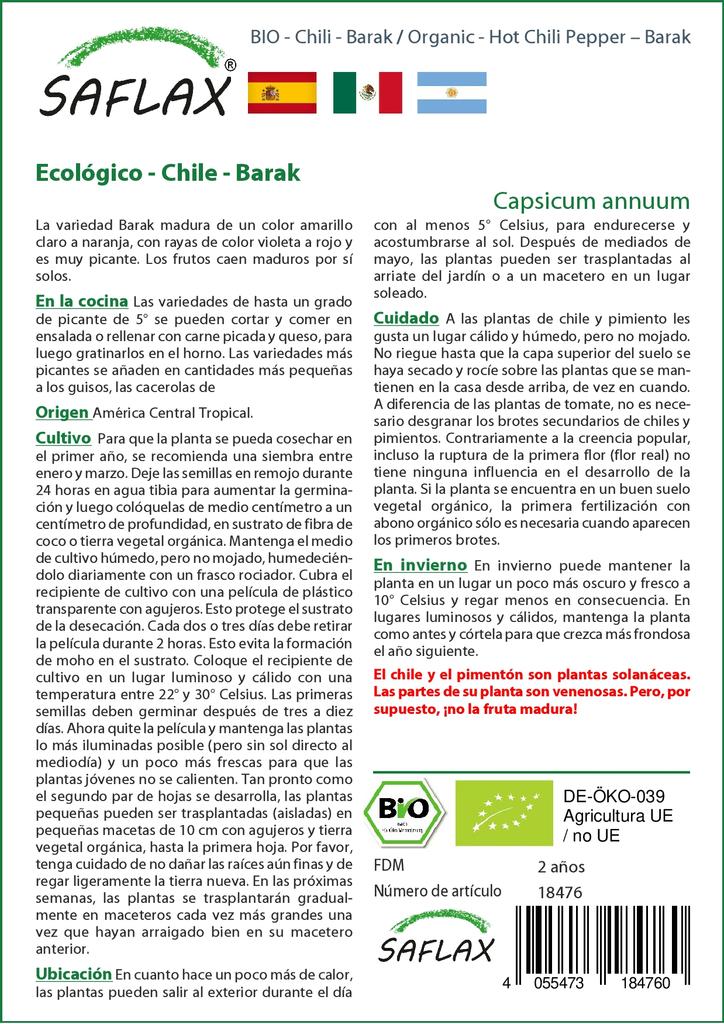Worth knowing:
Barak is a very spicy variety that matures from a pale yellow colour to orange with purple stripes and then to red. The ripe fruits will fall off by themselves.
Natural Location:
Tropical Central America.
Cultivation:
If you want the plant to bear fruits already in the first year, you should start propagation between January and March. Place the seeds in lukewarm water for about 24 hours to stimulate germination. After that, plant the seeds about 0.5 - 1 cm deep into moist coconut substrate or organic herb substrate. Keep your potting compost moist, but not wet – preferably by using a water sprayer for moistening. Cover the seed container with clear film that you provide with a few small holes. That way the substrate doesn’t dry out, but also gets some air. Every second or third day, you might want to take the clear film completely off for about 2 hours to avoid mold formation on your potting compost. Place the seed container somewhere bright and warm with a temperature between 22° and 30° Celsius. The first seedlings should already come up after 3 to 10 days. Now, you can remove the cover and keep the sprouts in a somewhat cooler, but bright place without exposing them to the hot midday sun. As soon as the seedlings develop the second pair of leaves, you can prick out until the first pair of leaves, and plant the sprouts into small 10 cm pots with a bottom hole and filled with organic vegetable substrate. Be careful not to damage the fine roots and don’t forget to moisten the fresh substrate. During the upcoming weeks and little by little you can move the plants into bigger pots, as soon as the roots have colonized the old pot.
Place:
As soon as the temperature rises to at least 5° Celsius, you can move the plants outside during the day, to allow them to slowly adapt to the sunlight and outdoor conditions. In mid May and after the Ice Saints, the plants can either be planted out at a sunny place in the garden patch or they can be moved into tubs.
Care:
Chili and Pepper plants prefer a warm and moist surrounding, but not too wet. Water the plant only when the surface layer of the soil has dried out. Indoor plants can be sprayed from above with a water sprayer every now and then. Unlike tomato plants, it is not necessary with chili and pepper plants to pluck out the side-shoots. Contrary to popular opinion, even removing the first flower bud has no influence on the growth of the plant. If you use organic vegetable substrate for cultivation, it becomes only necessary to give additional fertilizer after the first buds appear.
During the winter:
For hibernation, the plant can be kept in a somewhat darker and cooler place with a temperature about 10° Celsius. Accordingly, less watering is required. If you prefer to leave the plant in a bright and warm place, keep nurturing it as you did before and cut it back to achieve a bushy growth in the next year.
Picture credits:
- © Frank Laue - © Saflax - http://www.saflax.de/copyright
- © Frank Laue - © Saflax - http://www.saflax.de/copyright
- © Frank Laue - © Saflax - http://www.saflax.de/copyright
- © About © : Contact SAFLAX - - http://www.saflax.de/copyright
- © About © : Contact SAFLAX - - http://www.saflax.de/copyright
- © About © : Contact SAFLAX - - http://www.saflax.de/copyright
- © About © : Contact SAFLAX - - http://www.saflax.de/copyright
- © About © : Contact SAFLAX - - http://www.saflax.de/copyright
- © About © : Contact SAFLAX - - http://www.saflax.de/copyright














































